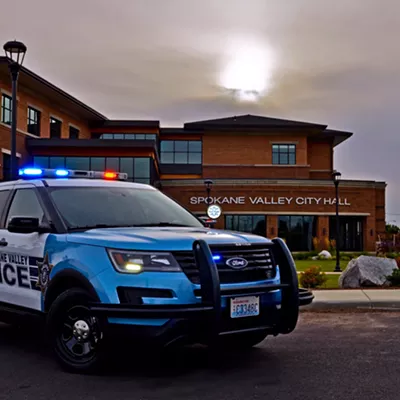In the United States, environmentalists have camped out in the top of trees or across logging roads for weeks to prevent logging of pristine forest or ancient redwoods. In Germany, activists recently chained themselves to railroad tracks in an effort to prevent trains carrying poisonous industrial wastes from moving. On the rough oceans across the world, other activists strapped to tiny rubber floats have sailed between heavily armed whale hunting vessels and their prey. It's getting more and more difficult to follow in the footprints of these professional activists, whose daredevil rappelling down sleek office buildings and tall smokestacks ensures their cause a spot on the evening news and a bit of public attention. Yet some still succeed on a shoestring budget.
Take Josh Burnim, for instance. The 27-year-old from Moscow, Idaho, looks like he came right from yoga class, not from completing a 64.5-mile leg of an 800-mile hike he began this spring. Clearly shy about all the media attention he has gotten since he began his wilderness adventure, it's a little difficult to get him to talk about himself in more than short answer form.
Yes, things are going as planned so far.
Yes, he thinks he'll complete the trip on time.
But don't be fooled. Ask him about wildlife preservation and what spending all this time in one of the biggest remaining wilderness areas in the country has meant to him, and his eyes light up.
"It's just incredible being out there, near the water and the mountains and the wildlife. I like to see things first-hand, to smell them and touch them and really sense them," he says. "I guess I'm fueling up for a lifetime of preservation work."
On May 7 this year, Burnim began a five-month hike from the Sawtooth Mountains near Idaho's Sun Valley to the Selkirk Mountains of British Columbia. He plans to get there by October 6, after having hiked a total of 800 miles divided into 18 separate trips, with short breaks between them. He averages about eight miles per day,
But what on earth possessed a soft-spoken transplant from New York to go on a wilderness hike like this?
"I want to direct attention to the fact that though some of the wilderness preservation areas are big, they are not big enough for grizzlies or other species like wolverines, that migrate," says Burnim. "I realize it's not feasible to create single areas that are big enough on their own. That's why connecting the wilderness preserves with wildlife corridors is a lot more feasible."
Almost no matter where you travel in Washington, Idaho and Montana, you find yourself close to a state park, a national forest or some other type of protected wilderness. But regardless of the sheer size of the acreage set aside for wildlife habitat, there's still a problem: If the land is scattered among large cities, between busy interstate highways and railroads, it makes it impossible for the animals to move from one area to another.
"It's very important for wildlife to be able to move between habitat areas," says Burnim. "When our parks, wildernesses and forests become islands of habitat surrounded by a sea of development, animals lose their ability to react appropriately to stressful events like floods and disease. They also lose their ability to find mates and establish home territories. As a society, we can help them by maintaining connections between habitats. It's all part of maintaining healthy wildlife populations that are good for human communities, too."
Burnim says he moved West from New York state five years ago to "find the big wild." With a degree in molecular biology from Colgate University, he plans to attend graduate school at the University of Montana in Missoula this fall to study the environment.
He quickly fell in love with the Idaho backcountry, hiking through it and becoming quite a skilled naturalist. As he became aware of the issues surrounding the disappearance of wilderness corridors, he thought hiking through the areas he is trying to protect would be an excellent way of getting to know the land, and to draw attention to the issues he's fighting for.
His journey is planned so it follows the remaining corridors between the protected wilderness areas in the Yellowstone to Yukon region.
"I'm hiking sort of as an elusive animal would," he says. "But that doesn't mean I don't talk to the people I meet. I try to talk to anyone I meet on the way that I don't feel intimidated by." So far, only a handful of rowdy ATV riders near Avery, Idaho, managed to "scare" Burnim off the road.
"I just didn't feel like talking to them. They were all loud and driving fast and all that," he explains. Adding to his feeling timid were also all the little yellow hiker-signs he'd seen hacked or sawed off on his way. In some areas, ATV and motorcycle traffic is prohibited or severely limited, but there are few people to watch over the signs in the remote areas.
"There is sign damage all over the place. Especially when the signs direct you to how you can travel and what you can do. The damage to the hiker signs really got to me. I guess people like me aren't always welcome," he says.
animals vs. people
One of Burnim's major sources of inspiration is Canadian wildlife biologist and park ranger Karsten Heuer, who hiked from the Yellowstone National Park to the Yukon Territory in 1998 and '99.
"He promoted the Yellowstone to Yukon Initiative (Y2Y) in that area. That's an initiative that encourages people to preserve the natural heritage in their area," says Burnim. "My dad told me about it a while back, and I guess I thought that was a fun, athletic way of drawing people's attention to the issues about wilderness corridors and the areas in question." Burnim's hike is focused more on the western part of the Yellowstone to Yukon area and on the connection between the Idaho wilderness areas and the wilderness in Southern British Columbia.
"That connection is crucial. Not long ago they had to shoot a grizzly bear in western Idaho. I imagine it had almost made it down from Canada, then it hit I-90," says Burnim. "It got way too comfortable around people, going through the trash for food and things like that. They tried relocating it, but it didn't work. Then, I guess it came up to this house, right outside the screen door and was standing up. The lady in the house got really scared, and she couldn't get it to go away. They shot it."
This is an example of what can happen to wild animals trying to migrate from one wilderness area to another, if they have to pass through heavily populated areas. While trying to pass through or around cities, the animals may become distracted from their original plan by such simple things as human trash.
"They get used to people and to looking for food among our trash," says Burnim. "If the migration patterns are to remain, the animals have to make it through the populated areas without being habituated to people."
The ability to migrate in search of food and territory is crucial to grizzlies, other bears and cougars. Young cougars sometimes end up taking up residence inside the city limits -- like the one that was seen several times in the Lincoln Park area of Spokane last year -- because urban sprawl and new developments have left little unoccupied cougar territory outside of the city.
Wolf packs need a relatively large area to roam as well, an area which recent tracking of newly released radio-collared wolves has shown is much bigger than first estimated. Since wolves began being reintroduced in Yellowstone National Park some years back, their roaming has caused problems between ranchers, who've lost livestock and insist on their right to defend it against predators, and environmentalists, who say wolves are an integral part of a well functioning wilderness ecosystem.
Burnim travels through some of the prime bear and wolf habitat in the entire country, and he has had a few encounters with both.
"We were in wild Clearwater country, and we came down to the creek to camp and get water. We hung our food on a bear line and were just kind of hanging out, I think it was around 4 pm," says Burnim. "And we heard this weird noise. I mean, it took a while before we figured out what it was -- but it was wolves, howling in the middle of the day. They howled for about two minutes... it was pretty amazing. We'd seen a lot of big wolf paw prints getting down there, so I guess we shouldn't be that surprised."
Elusive as they are, Burnim didn't actually see the wolves, but he saw plenty of signs that he was in the middle of their territory. "The next day going up the river, we saw tons of new wolf tracks in the snow," he says.
Wilderness corridors are not designated areas that can be found on a regular road map. They are simply migratory routes that wildlife biologists have determined are used by larger mammals living in the area. They fall on both federal lands -- that's why protection of the roadless areas is so important, says Burnim -- and on private lands. He adds that although some landowners may be suspicious of more government regulations, he feels certain they all appreciate the wildlife around them.
"I know it's hard for the people who make their living on the land in these migratory areas, but a lot can be achieved through education," says Burnim. "Simple things can be done to accommodate the migrating animals, like the lifting of fences when it's not grazing season, so smaller animals can pass underneath."
Even relatively small animals such as lynx have surprisingly large roaming areas, which have just recently been documented by Canadian researchers.
Burnim passes through several grizzly recovery areas, too, but so far has only seen smaller bears.
"I've seen two black bears altogether. One day, it was at dusk, right after dinner, we saw a black bear walking down the slope on the other side of the river -- but it didn't see us. So we clapped our hands, and the bear looked right at us," says Burnim. "Then it kind of got up, marked a tree, you know, stretched out and scratched it, and turned around and rubbed its back up against it. Then it just kind of left. It was pretty amazing."
Creating the connection
The main point about Burnim's hike is to create a connection between people and the wilderness. Regular people, that is.
"I think a hike really connects people with the land they hike through. In debates, we often don't talk about specific places, we just talk about wilderness or roadless areas that people can't really identify with," says Burnim. "Hiking is a way for people to actually get to know the land and see the places they are talking about. It establishes a clear connection with the land."
In order to spread the word about the areas he is hiking through, some of the stretches of Burnim's trip are public hikes. "I want people to come along and see what it is I'm talking about," he says.
This weekend's Rock Creek public hike with Burnim takes place around the spot where Highway 200 crosses Rock Creek, about a mile from Noxon. Mont. It begins the morning of Saturday, July 21, with a tour of the proposed mining site there, sponsored by the Sierra Club and the Rock Creek Alliance.
The federal government has not yet decided whether to permit Sterling Mining Company's plans to tunnel beneath the Cabinet Wilderness Mountains, where the company hopes to extract more than 100 million tons of rock containing copper and silver ore. Opponents of the plan fear that mining waste will migrate from the site and pollute the Clark Fork River and Lake Pend Oreille.
The project has been protested heavily by local environmentalists, but many fear the permit is a done deal, mostly because it's the first major mining decision of the George W. Bush administration. After the tour of the mine site, the hike continues for a short distance up the East Fork of Rock Creek.
The next public hike, which is cosponsored by the Lands Council and the Spokane Mountaineers (among others), is at Upper Priest Lake on Sept. 1.
"This is definitely why people who live in Spokane and other cities around here should care," says Rein Attemann, the Lands Council's Forest Watch and Selkirk Coordinator. "Many of us have cabins or go skiing or hiking up by Priest Lake or in some of the other areas that Burnim is hiking through. This is a great way for people to see the land and learn about the wildlife."
Once the hike is over, Burnim plans to hit the road again with a slideshow and, quite possibly, a book based on the journal entries he's made along the way.
"Like I said, I came West to find the big wild, and I did," he laughs. "I know the preservation of wildlife corridors is not going to be accomplished overnight; it's more of a 100-year vision. But this is my great trip of a lifetime. It's great to be able to combine that with something that's so worthy of preservation."
For a schedule of public hikes and to track Burnim's progress, visit www.wildrockies.org/idahohike/ or call (406) 728-1170. There is a limited number of openings for these hikes, so you must call ahead.














